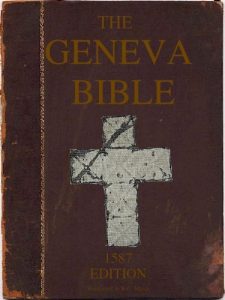The Geneva Bible is one of the most historically significant translations of the Bible into the English language, preceding the King James translation by 51 years. It was the primary Bible of the 16th century Protestant movement and was the Bible used by William Shakespeare, Oliver Cromwell, John Milton, John Knox, John Donne, and John Bunyan, author of Pilgrim's Progress. It was one of the Bibles taken to America on the Mayflower, it was used by many English Dissenters, and it was still respected by Oliver Cromwell's soldiers at the time of the English Civil War.
What makes this version of the Holy Bible significant is that, for the very first time, a mechanically printed, mass-produced Bible was made available directly to the general public which came with a variety of scriptural study guides and aids (collectively called an apparatus), which included verse citations which allow the reader to cross-reference one verse with numerous relevant verses in the rest of the Bible, introductions to each book of the Bible which acted to summarize all of the material that each book would cover, maps, tables, woodcut illustrations, indexes, as well as other included features — all of which would eventually lead to the reputation of the Geneva Bible as history's very first study bible.
Because the language of the Geneva Bible was more forceful and vigorous, most readers preferred this version strongly over the Bishops' Bible, the translation authorized by the Church of England under Elizabeth I. In the words of Cleland Boyd McAfee, "it drove the Great Bible off the field by sheer power of excellence".
The two other most significant editions of the Geneva Bible are the 1587 Tomson New Testament edition and the use of the notes of Franciscus Junius on Revelation from 1599 on. Also of note are the Geneva Bible editions of 1568-1570, which contain Calvin’s Catechism, and later editions which included Calvinistic doctrine as catechism.
Lawrence Tomson brought out a New Testament in 1576, based on Beza’s Greek and Latin New Testaments, and using Beza’s Latin New Testament notes. Tomson’s New Testament, including the margin notes, replaced the Geneva 1560 New Testament in a 1587 quarto edition of the Geneva Bible. While there were some changes in the biblical text, the major difference in the Tomson New Testament was in the margin notes. Some readers continued to prefer the Geneva Bible 1560 New Testament version. This resulted in some Geneva Bibles having the 1560 New Testament and notes and others having Tomson’s New Testament and notes, from 1587 on.
1587 Geneva Bible with marginal notes, formatted for the Kindle E-Book reader.
What makes this version of the Holy Bible significant is that, for the very first time, a mechanically printed, mass-produced Bible was made available directly to the general public which came with a variety of scriptural study guides and aids (collectively called an apparatus), which included verse citations which allow the reader to cross-reference one verse with numerous relevant verses in the rest of the Bible, introductions to each book of the Bible which acted to summarize all of the material that each book would cover, maps, tables, woodcut illustrations, indexes, as well as other included features — all of which would eventually lead to the reputation of the Geneva Bible as history's very first study bible.
Because the language of the Geneva Bible was more forceful and vigorous, most readers preferred this version strongly over the Bishops' Bible, the translation authorized by the Church of England under Elizabeth I. In the words of Cleland Boyd McAfee, "it drove the Great Bible off the field by sheer power of excellence".
The two other most significant editions of the Geneva Bible are the 1587 Tomson New Testament edition and the use of the notes of Franciscus Junius on Revelation from 1599 on. Also of note are the Geneva Bible editions of 1568-1570, which contain Calvin’s Catechism, and later editions which included Calvinistic doctrine as catechism.
Lawrence Tomson brought out a New Testament in 1576, based on Beza’s Greek and Latin New Testaments, and using Beza’s Latin New Testament notes. Tomson’s New Testament, including the margin notes, replaced the Geneva 1560 New Testament in a 1587 quarto edition of the Geneva Bible. While there were some changes in the biblical text, the major difference in the Tomson New Testament was in the margin notes. Some readers continued to prefer the Geneva Bible 1560 New Testament version. This resulted in some Geneva Bibles having the 1560 New Testament and notes and others having Tomson’s New Testament and notes, from 1587 on.
1587 Geneva Bible with marginal notes, formatted for the Kindle E-Book reader.






